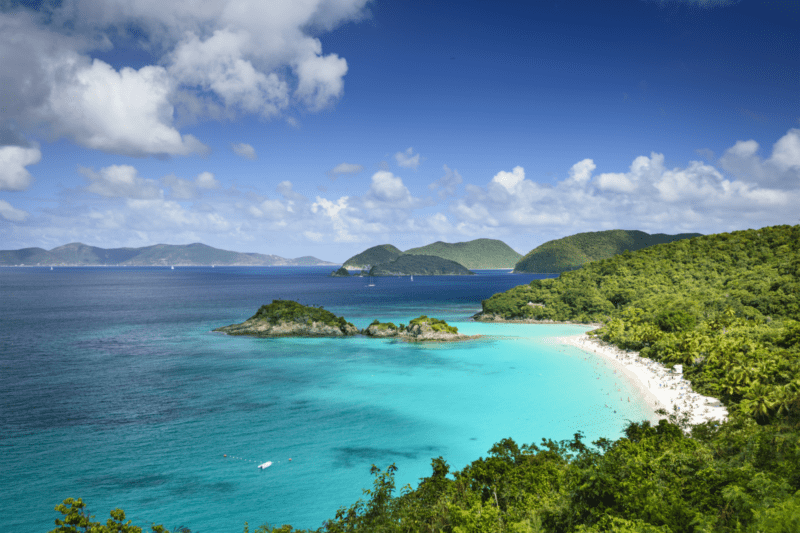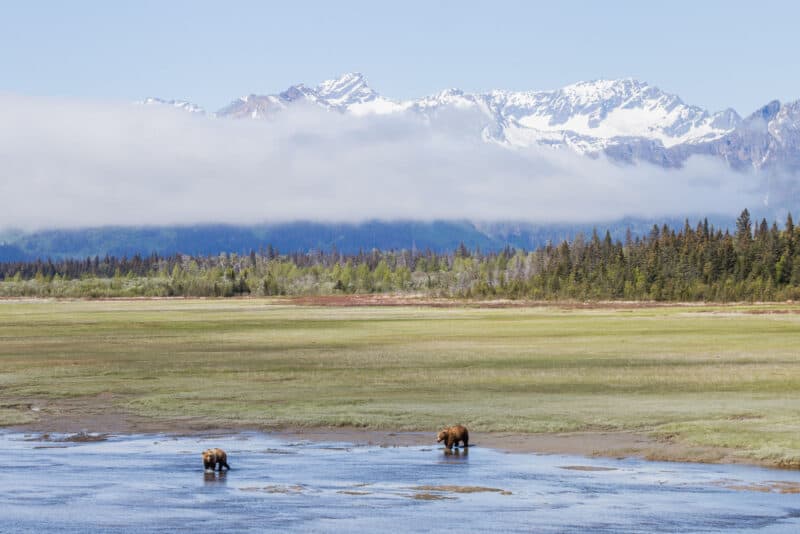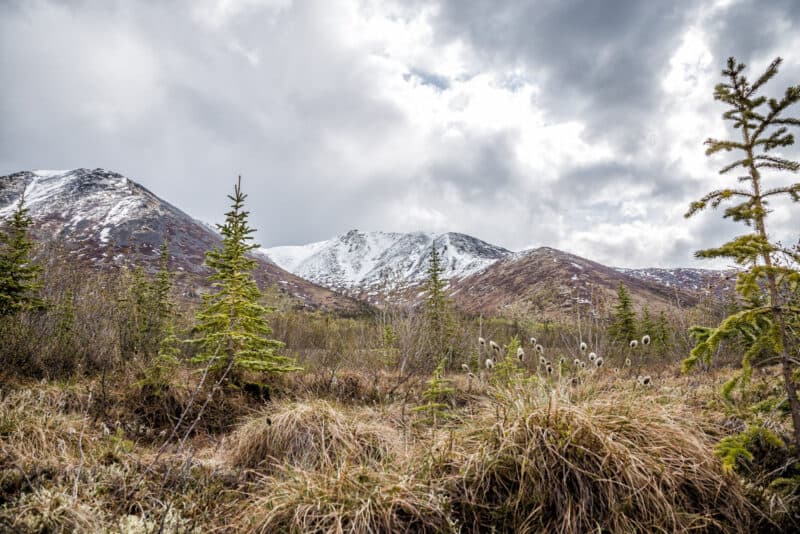If you’re looking for an adventure-fueled getaway but want to beat the crowds, you should consider visiting the least visited National Parks in the United States. Don’t get me wrong, the National Parks that get all the visitors are spectacular.
But if you’re anything like us, sometimes you just want to enjoy nature without the crowds. This is ultimately what draws us to some of these lesser-known parks and the main reason we love exploring them.
The parks on this list have had the least visitors over the past five years. We assure you these low visitor figures are not due to the parks’ lack of natural beauty but instead their difficult accessibility with many being located in remote parts of the country.
To put together this list, we used the 2022 visitation data (released in February 2023). We analyzed the data to create lists of the least visited national parks and the most visited national parks across the USA.
In promoting travel to the USA National Parks, it is important to us that you understand that most of the park lands are the traditional and/or sacred lands of many First American and Indigenous groups. We want to share a formal land acknowledgment that extends our appreciation and respect to the past and present people of these lands. We invite you to check out Native Land to learn more about the people who call these lands home.
Looking for more? Check out:Ultimate US National Parks Bucket List (All 63 Parks By State)
Least Visited National Parks Map
Table of Contents
HOW TO USE THIS MAP: Above you’ll find a map of our highlights for visiting the least visited National Parks in the USA. Click on the top left of the map to find separate layers marking the route and points of interest. You can hide and show different layers, or click icons on the map to see the names of places we mention in this travel guide. “Star” the map to save it to your own Google Maps, or open the map in a new window for a larger version.
15 Least Visited National Parks in the USA
15. Pinnacles National Park, California

- Annual Recreational Visits: 275,023 (2022 NPS Report)
- Location: California
- Size: 26,606 acres
- Established: 2013
The Pinnacles National Park is located in rural California just east of Salinas Valley and is around 30 minutes from any nearby towns. A new national park radiating peace and tranquility making it hard to believe it was an ancient active volcano field 23 million years ago.
Key landmarks within the park include the Balconies and Bear Gulch Caves, which are home to hundreds of wild bats. There are plenty of scenic trails available in the park which will take you past both these caves.
Arguably the best time to go to Pinnacles national park is in the spring as temperatures remain mild, and you will get to appreciate the park’s beautiful natural wildflowers. The night sky at this time of the year is amazing, so be sure to get your camping chair to gaze above.
14. Voyageurs National Park

- Annual Recreational Visits: 221,434 (2022 NPS Report)
- Location: Minnesota
- Size: 218,200 acres
- Established: 1975
The 200,000+ acre Voyageurs National Park is located in the state of Minnesota between the boreal forests in the north and the deciduous forests towards the south of the state. It is home to four huge lakes along with masses of waterways, peninsulas, and islands.
The Park provides a variety of action-packed activities including boating and kayaking. A main draw of the park is the variety of wildlife including being home to hundreds of bald eagles – we saw at least five in the first few minutes of arriving at the park.
A visit to the park is most popular throughout the summer season between May and August, but there is also the opportunity to go snowmobiling here in the winter months.
Minnesota is filled with so many great things to do, here’s our favortes. 28 Amazing Things to Do in Minnesota (From A Local!)
13. Guadalupe Mountains National Park

- Annual Recreational Visits: 219,987 (2022 NPS Report)
- Location: Texas
- Size: 86,367 acres
- Established: 1972
Located in Texas near the border of New Mexico is the impressive Guadalupe National Park of the Guadalupe Mountains which stretches 135 square miles. Located inside the park is the world’s most extensive Permian fossil reef which also includes the four tallest points in the state.
Visitors are drawn to the park due to its unique biodiversity as you are able to explore a variety of different environments. Popular trails include Devil’s Halls and McKittrick Canyon which both leave you wandering between canyon walls and provide spectacular views.
12. Congaree National Park

- Annual Recreational Visits: 204,522 (2022 NPS Report)
- Location: South Carolina
- Size: 26,276 acres
- Established: 2003
Located on the outskirts of the popular city of Columbia, South Carolina is Congaree National Park. Hosting forested wetlands, swampy-style lakes, and some of the tallest deciduous trees in the world, Congaree is a spectacular natural beauty.
With over 25 miles of trails, you will get to explore a range of biodiverse wildlife such as turtles, snakes, and alligators. If you fancy an alternative option to hiking, the park offers both kayaking and paddle boarding where you can take in incredible views from on top of the water.
The best time to visit Congaree National Park is when winter meets spring, providing perfect conditions and fewer crowds.
11. Virgin Islands National Park

- Annual Recreational Visits: 196,752 (2022 NPS Report)
- Location: US Virgin Islands
- Size: 14,737 acres
- Established: 1956
Located in a luscious tropical paradise in the Caribbean is the natural beauty of the Virgin Islands National Park. This national park’s rural location along with its small and intimate feel may be the reason it’s on this list of least visited national parks.
Despite offering stunning natural landscapes, this park also offers and a chance to explore history. The Park is home to the Annaberg Plantation Ruins which are remains of when St. John was colonized by Danish settlers.
The Park is also home to many trails to explore from hillsides to beaches jam-packed with unique adventures. Located in a prime position opposite the visitor center is the Caneel Bay Resort, which is a laid-back hotel perfect for families heading to the national park.
We visited this park in the month of January and enjoyed clear visibility for snorkeling and warm weather.
Here’s everything you need to know about visiting the US Virgin Islands: What to do in St Thomas US Virgin Islands (Attractions, Beaches, Food & Itinerary Planning)
10. Great Basin National Park

- Annual Recreational Visits: 142,115 (2022 NPS Report)
- Location: Nevada
- Size: 77,180 acres
- Established: 1986
Great Basin National Park is located in eastern Nevada close to the Utah border and is home to 77,000 acres of luscious landscapes. The magical scenery includes flourishing meadows, alpine lakes, and rigid mountains along with being home to Nevada’s only glacier.
This park is a major hidden gem in the United States! Despite its small size and relative remoteness, it is one of our favorite US National Parks!
There are multiple trails to hike in Great Basin NP, most of which are interconnected, and offer unique Bristlecone Pine trees, some of which are the oldest trees in the entire country. Many of them look dead, although they are not, creating a spooky atmosphere along the trails.
A key asset to the park is 13,063 feet Massive Wheeler Peak rise which provides views of dry deserts meeting alpine forests.
The best time to visit this park is in early fall when the park offers mildly warm days along with crisp nights. We visited the first week of September and had enjoyable weather.
9. Dry Tortugas National Park

- Annual Recreational Visits: 78,488 (2022 NPS Report)
- Location: Florida
- Size: 47,125 acres
- Established: 1992
Dry Tortugas National Park consists of 7 desert islands clustered together 70 miles off the coast of Key West, Florida. The islands lie in the shimmering waters of the Gulf of Mexico and can be accessed by seaplane or ferry.
Home to some of the best diving in the US, its low visitor numbers make it a diver’s haven as the coral conditions are thriving away from human development. If you fancy making a night of it, you will be astounded by the stargazing opportunities.
We took the seaplane flight from Key West to Dry Tortugas, there is also a ferry option, and it was one of our most exciting National Park visits to date. We wrote an extensive guide about our visit that you can view here: How to Get to Dry Tortugas National Park
More information for planning your trip to Dry Tortugas:
8. Wrangell-St. Elias National Park

- Annual Recreational Visits: 65,236 (2022 NPS Report)
- Location: Alaska
- Size: 13,175,799 acres
- Established: 1980
Next on the list is Wrangell-St. Elias National Park, which is in the icy northern state of Alaska. The Park is over 13 million acres and is by far the biggest state in the entire United States, making it hard to believe it is one of the least visited national parks.
It features an abundance of Alaska’s spectacular glaciers and is home to the world’s biggest non-polar icefield.
Get a real sense of being in the wilderness with a trip here as you explore steep scree slopes, glacial terrains, and crevassed glaciers. Due to there only being two main roads in the park, it makes sense to see the park by water!
Rafting here is said to be a lifetime bucket list activity as you get to explore pristine, untouched waters. The best time to visit the park is from September to April as you may get the chance to view the famous northern lights.
7. Katmai National Park and Preserve

- Annual Recreational Visits: 33,908 (2022 NPS Report)
- Location: Alaska
- Size: 4,093,077 acres
- Established: 1980
Katmai National Park has two main drawing factors – volcanoes and bears. The four-million-acre park located in Southern Alaska has the largest population of brown bears in the United States.
Its remote location is around 250 miles southwest of Alaska’s largest city Anchorage and is typically only accessed by plane making it a true wilderness destination.
The best time to visit Alaska is typically between June-September as this is when the national park visitor center is open and weather patterns aren’t as extreme.
Hotspots in the park include the spectacular views from Observation Mountain and The Savonoski Loop where you have the opportunity to camp or stay in wooden cabins.
6. North Cascades National Park

- Annual Recreational Visits: 30,154 (2022 NPS Report)
- Location: Washington
- Size: 504,654 acres
- Established: 1968
North Cascades National Park is dubbed to be the ‘America Alpes’ with sharp rugged peaks is the North Cascades National Park. Located in the state of Washington, the park stretches over 500,000 acres of glacial mountains and forested valleys.
A visit to the park will allow you to immerse yourself in nature, and you can spot some unique wildlife from black-tailed deer to black bears, and mountain lions.
The stunning Ross Lake Resort is the perfect destination to stay at. You’ll float on picturesque cabins with stunning views of the pristine lake and snow-capped mountains.
5. Isle Royale National Park

- Annual Recreational Visits: 25,454 (2022 NPS Report)
- Location: Michigan
- Size: 571,790 acres
- Established: 1940
Located near the Canadian border in the state of Michigan is Isle Royale National Park which only draws 25,000 visitors each year. This is not due to its lack of natural beauty but instead its difficult accessibility with visitors having to make a five-hour ferry ride to visit the park.
The national park is famous for its rugged forests, extensive hiking trails, and crystal-clear lake waters. A famous landmark is the brick and stone lighthouse, which lies elegantly amongst the vast surrounding pine trees.
There are multiple campgrounds to stay in where you will be surrounded by the native majestic moose. There is also a historic resort and some companies offer multi-day kayak trips.
4. Lake Clark National Park and Preserve

- Annual Recreational Visits: 18,187 (2022 NPS Report)
- Location: Alaska
- Size: 4,030,015 acres
- Established: 1980
Lake Clark National Park is huge and consists of over 4,000,000 acres of rural road-free land in a peninsula Southwest of Alaska. The biggest draw to this park is the accessibility to explore bear territory – here you will get to see bears in their wild, undisturbed homes.
Of all the wildlife adventures we’ve had around the planet, our time spent at Bear Camp in Lake Clark NP is one of the most memorable ones for us.
The Park is also home to an abundance of sharp glaciers, monstrous volcanoes, and the beautiful Lake Clark.
Lake Clarke provides a spectacle with over three million sockeye salmon migrating to its waters each year. If you’re looking to get down with nature, there is plenty of backcountry camping available which is permit-free.
Alternatively, if you’re looking for a bit more comfort, there are multiple guest houses around Lake Clark.
3. Kobuk Valley National Park

- Annual Recreational Visits: 16,925 (2022 NPS Report)
- Location: Alaska
- Size: 1,750,716 acres
- Established: 1980
Kobuk Valley National Park is in northwestern Alaska, just north of the famous Arctic. The Park is home to robust Great Kobuk Sand Dunes, covering up to 25 square miles each.
Kobuk is the definition of getting out into the deep wild as there is no road access and most people must fly a small aircraft to visit the park.
The park is home to hundreds of different wildlife species including thousands of caribou which migrate through the area every year. It’s open all year round, but it doesn’t boast any development facilities so come prepared!
Looking for more amazing places to visit in Alaska? Check out our detailed Alaska Travel Guide
2. Gates of the Arctic National Park and Preserve

- Annual Recreational Visits: 9,457 (2022 NPS Report)
- Location: Alaska
- Size: 8,472,506 acres
- Established: 1980
Finally, the national park with the least annual visitors is Gates of the Arctic National Park and Preserve which hosts less than 10,000 people per year.
This Park is extremely remote and difficult to access with no roads and limited trails for visitors. However, its rugged and jaw-dropping views along with its incredible wildlife make it an isolated wonderland and a bucket list destination.
A perfect location for adrenaline junkies, the Arrigetch Peaks provide great jagged granite rocks to climb where you can reach heights displaying spectacular views overlooking the valley.
Despite its lack of visitors, the park covers an extortionate 13,238 square miles across the Arctic Circle giving many the sense of having the park all to themselves. This is something we can attest to from our 2017 visit to the park.
To visit the park, we took a small plane from Fairbanks to the town of Coldfoot. From there, we traveled by road along the Dalton Highway to visit this park. It’s amazingly beautiful but harsh to visit.
1. National Park of American Samoa

- Annual Recreational Visits: 1,187 (2022 NPS Report)
- Location: American Samoa
- Size: 13,500 acres
- Established: 1988
Located in the heart of the South Pacific are three tropical islands creating American Samoa National Park. Lying beneath the equator these picturesque islands consist of volcanic rocks, tropical rainforests, and breathtaking beaches.
Switch up your campervan and barbeques for an exotic snorkeling trip as just under a third of the park’s surface is underwater. Immerse yourself in the island’s hundreds of coral and fish species for an irreplaceable adventure.
Did you know the American Samoa is one of the most tropical places in the world that America’s can visit without a passport? More info here: Where To Travel Without a Passport: Tropical Beaches and Exotic Places
You might also like:
- Ultimate USA Travel Guide
- Best Hikes in the USA: 15 Stunning Trails You Shouldn’t Miss
- How to Plan A Road Trip in 10 Easy Steps

